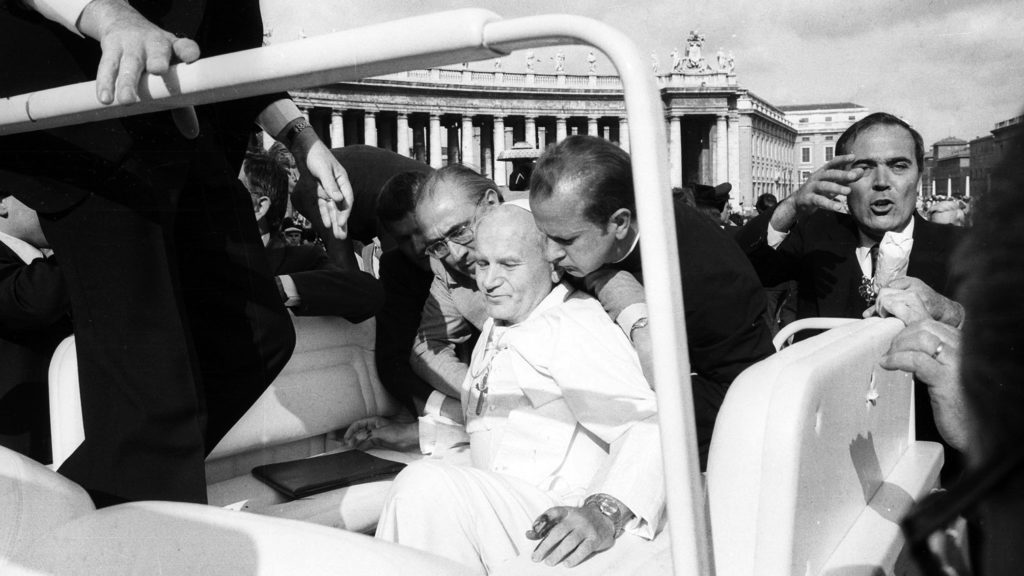ROME – In the sports movie “Any Given Sunday,” a coach, played by Al Pacino, delivers a locker room speech about how football is a game of inches: “One half step too late or too early, and you don’t quite make it,” he says. “One half second, too slow, too fast, you don’t quite catch it. … The inches we need are everywhere around us.”
Last Sunday’s assassination attempt against former U.S. President Donald Trump offered a reminder that history, too, is often a game of inches, one in which potentially massive shifts pivot on an incredibly small margin.
Catholics certainly know that to be true, as more than two millennia of Church history indisputably confirm the point.
In recent times, the most celebrated example is the May 13, 1981, assassination attempt against St. Pope John Paul II, now St. John Paul. The pontiff was struck twice by bullets fired by would-be assassin Mehmet Ali Ağca, and had the shot that lodged in his torso been even a half-inch or so to the left or right, damage to his heart and his aorta likely would have caused a swift death.
John Paul was convinced his life was spared by the intervention of Our Lady of Fátima, and on the first anniversary of the assassination attempt, he traveled to Fátima to place the bullet that doctors had removed from his body in the crown of the statue of the virgin in order to thank her for her intervention.
That, however, is merely the best-known instance in a long line of near misses.
In the early centuries of the Church, at least 30 popes died as martyrs, including, famously, the very first one, St. Peter. Later, popes also fell victim to less noble deaths — including a handful who were strangled by political enemies, and one, Pope John XII, who may well have been murdered by the jealous husband of a woman with whom he was discovered in bed.
For every pope who succumbed to an assassination attempt, however, there are others who staged narrow escapes.
To take one example, Pope Leo X, a Medici pope, was the target of an assassination plot in 1516 orchestrated by his rival Cardinal Alfonso Petrucci, who enlisted the pope’s personal physician and others. The plan was discovered when a letter from the cardinal to his private secretary fell into the wrong hands, with the result that Petrucci was strangled and the other conspirators were drawn and quartered.
It was Leo, by the way, whose constant need for money, in part for the renovation of St. Peter’s Basilica, led to a flourishing trade in indulgences which helped fuel the Protestant Reformation. It’s anybody’s guess how things might have played out if the 1516 plot had actually succeeded.
A half-century later, between 1562 and 1564, Pope Pius IV, another Medici, was the target of at least three separate assassination attempts. One was staged by an armed man for unknown reasons, another engineered by members of the rival Carafa clan (Pius had ordered Cardinal Carlo Carafa strangled in 1561), and the third was set in motion by a group of intransigents unhappy with Pius’ conciliatory policies toward Protestantism.
In that last instance, the plot fell apart when the would-be assassin, who had planned to stab Pius with a poisoned knife during an audience, lost his nerve. The other conspirators then essentially fell over one another to be the first to confess, hoping to escape the worst punishment.
Such near misses are not merely a dusty relic of eras gone by, but have continued into modernity.
During St. Pope Paul VI’s 1970 journey to the Philippines, for example, a Bolivian surrealist painter named Benjamín Mendoza y Amor Flores approached the pontiff as he deplaned, crying “death to superstition!” and stabbing him twice in the neck with a short dagger, both times narrowly missing the jugular vein. The pope continued with his program, and his injuries weren’t revealed until after his death in 1978.
In terms of Mendoza’s motive, he would later volunteer the banal explanation that he simply wanted to “attract attention.”
(As a footnote, one of the papal aides who subdued Mendoza and helped save the pope’s life was American Archbishop Paul Marcinkus, who would later go on to celebrity as head of the Vatican Bank during the scandals of the late 1970s and ’80s. The Filipino government tried to gin up a story that then-President Ferdinand Marcos had delivered a karate chop to the would-be assassin, thereby saving the day, but no one ever really bought it.)
One can only imagine how different the implementation of the Second Vatican Council, for instance, might have been had Paul died violently five years after its close.
As it turns out, the celebrated 1981 incident wasn’t John Paul’s only close call either.
One, actually, came on that very trip to Fátima the next year to thank the virgin for her intercession. On that occasion, a mentally unstable Spanish traditionalist priest named Juan María Fernández y Krohn stabbed John Paul with a bayonet removed from a Mauser rifle, yelling as he did so, “Down with the pope, down with the Second Vatican Council.”
The unrepentant Fernández y Krohn spent three years in a Portuguese prison before being released and deported, and later said he didn’t regret the assassination attempt even if he wouldn’t repeat it. He even had the nerve to complain that while John Paul had forgiven Ağca, the pontiff never offered a similar pardon to him.
Again, it’s one of history’s great counterfactual questions to ponder how late 20th-century history might have played out differently if the pope who eventually helped bring down Communism had been killed instead, either in 1981 or 1982, both well before the fall of the Berlin Wall.
Nor were John Paul’s brushes with destiny quite finished.
When the Polish pope himself traveled to Manila in 1995, following in the footsteps of Paul VI, he too was the target of an assassination attempt, though in this case one that fell apart even before the pope arrived. We now know that Ramzi Yousef and Khalid Sheikh Mohammed planned to employ a suicide bomber to kill the pope during his visit, as part of a larger series of terrorist acts, which were also to include blowing up commercial airliners and attacking various targets in the United States, including CIA headquarters.
The plan, known as the “Bojinka plot,” collapsed when a chemical fire at the terrorists’ hideaway alerted authorities in Manila, and the various assaults never materialized.
By 1995 the Soviet empire had already fallen, but much else about the next decade might have been very different had John Paul not been around to shepherd the Catholic Church until his death in 2005.
In general, the security membrane around popes is actually much thinner and more porous than that which surrounds U.S. presidents and other public figures. In part, that’s because popes are pastors and put a premium on closeness to the people; in part, too, it’s because popes are believers who trust their fate ultimately is in God’s hands.
As a result, the surprise is probably not that recent history has featured several Trumpesque narrow escapes for pontiffs. Rather, it’s that such flirtations with disaster don’t happen more often.

